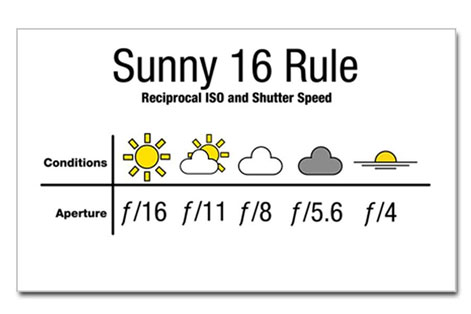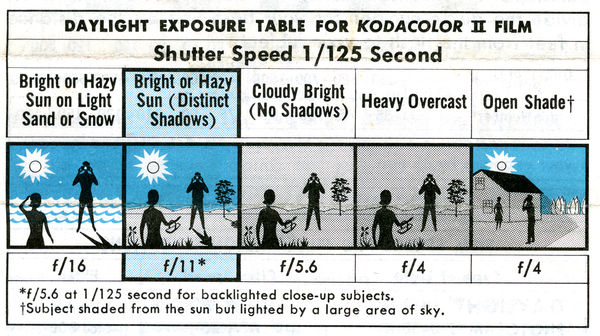What does "sunny 16" mean?
Oct 6, 2017 12:50:08 #
I frequently see "the sunny 16 rule" referred to in a variety of threads. I don't know what this means. Rather than hi-jack someone else's question, I am posting my own. I'm certain that many members will be able to help me understand this term.
Thank you.
Thank you.
Oct 6, 2017 12:54:26 #
Oct 6, 2017 12:55:41 #
DJO wrote:
I frequently see "the sunny 16 rule" referred to in a variety of threads. I don't know what this means. Rather than hi-jack someone else's question, I am posting my own. I'm certain that many members will be able to help me understand this term.
Thank you.
Thank you.
It is a rule for knowing an exposure when you have no light meter (handheld or in the camera). Not a likely situation with a digital camera. The simple rule gives an approximate or "ball park" daylight exposure. At f/16 a daylight exposure in full sun is a shutter speed of 1/ISO s. So for example: Say you want to shoot at an ISO (or old film ASA) of 400. You set you lens and camera at f/16 and shutter speed of 1/400 s. Or any equivalent exposure for ISO 400 such as
f/22 @ 1/200 s
f/16 @ 1/400 s
f/11 @ 1/800 s
f/8 @ 1/1,600 s
f/5.6 @ 1/3,200 s
etc.
You might not get these precise shutters speeds manually, but say 1/250 s or 1/3,000 s or 1/2,500 would work fine.
Oct 6, 2017 13:17:29 #
Maybe he trusts his buddies on the forum he belongs to rather
than random answers he might get on Google
than random answers he might get on Google
Oct 6, 2017 13:26:43 #
DJO wrote:
I frequently see "the sunny 16 rule" referred to in a variety of threads. I don't know what this means. Rather than hi-jack someone else's question, I am posting my own. I'm certain that many members will be able to help me understand this term.
Thank you.
Thank you.
Print this out and put it in your wallet:
If your camera battery dies and your exposure meter no longer works, you can use this rule to estimate proper exposure based upon the weather.
Oh, wait. You probably have a digital camera, not a film camera. Well, in that case, doesn't seem like it's that useful.
Well, here is one way to use it. Suppose you are shooting with a mirrorless camera, with minimum ISO of 200. Suppose you want to use a flash for fill, and you don't have high speed sync or don't want to lose the power associated with it, so your max sync speed is 1/200. But, you want to use a wide aperture for shallow depth of field (say f/1.8).
Since f/16 is about 6 stops darker than f/1.8 (actually f/2), and you already have reciprocal ISO equal to max shutter speed, then you need to darken the image by up to 6 stops with a neutral density filter. Generally, you want fill to be 1-3 stops below nominal exposure. That means you need a 2-4 stop neutral density filter. I'll usually grab a 3-stop.

Oct 6, 2017 13:51:21 #
Remember how most new film came with a little brochure that had the exposure chart printed on it?

Oct 6, 2017 13:53:05 #
DJO wrote:
It is also known as the Basic Daylight Exposure (BDE)! As long as the sky is clear and the sun is at least 20% above the horizon you will get a consistent and predictable exposure (within one tenth of a stop)! That means if you change the camera's current ISO number into the closest shutter speed, your exposures will be correct (like ISO 400, then f/16 and 1/400s will be correct! If you use this as your starting point you will not need a lightmeter at all, you just step out the door, look at the surrounding and you can set your camera to a correct exposure, by simply evaluating the light, you just have to add or subtract one, or several f-stops from your BDE and you'll be fine! The Brookls Institute of Photography actually supplies a list of the most common scenarios and the amount of according f-stops!I frequently see "the sunny 16 rule" referred to in a variety of threads. I don't know what this means. Rather than hi-jack someone else's question, I am posting my own. I'm certain that many members will be able to help me understand this term.
Thank you.
Thank you.
Oct 6, 2017 13:59:37 #
Following suggestions for f-stop above, the other portion of BDE is to match shutter speed to ISO. So, in bright daylight with f/16, shutter speed 1/200th and ISO 200.
Sunny 16, which only works in manual mode, is a great place to start. You also have to use your camera’s exposure compensation to correct for local conditions as seen through the viewfinder.
Sunny 16, which only works in manual mode, is a great place to start. You also have to use your camera’s exposure compensation to correct for local conditions as seen through the viewfinder.
Oct 6, 2017 14:04:53 #
lamiaceae wrote:
It is a rule for knowing an exposure when you have... (show quote)
There is looney f11 for moon shots also 1/ISO for shutter speed. Possibly more useful as more often than not camera meters just over expose due to the overwhelming dark of the night sky.
If you know your exposure triangle you can easily figure out an equivalent exposure.
iso doubles each stop 100, 200, 400, 800
shutter speed also 1/60 1/120th 1/250th 1/500th (getting faster by a stop at a time)
aperture f2, f2.8, f4, f5.6, f8, f11, f16, f22 each aperture hole is half the area of the one before it.
so if iso100 f11 1/100th (roughly) f8 could be iso 100 1/200th ish. or iso 200 and 1/100th.
Oct 6, 2017 14:43:33 #
Oct 6, 2017 15:49:27 #
jcboy3 wrote:
Spot meter.
moon is about 1/2 a degree in the sky, still quite small for a spot meter.
Oct 6, 2017 16:02:44 #
This worked better with negative film, which was more forgiving, than with slide film. On the second week {of a two week vacation} some years ago, the light meter built into my camera quit ... so I purchased color negative film to replace the Kodachrome I regularly used, and then we went on, and the pictures turned out just fine.
Oct 6, 2017 16:05:12 #
rehess wrote:
This worked better with negative film, which was more forgiving, than with slide film. On the second week {of a two week vacation} some years ago, the light meter built into my camera quit ... so I purchased color negative film to replace the Kodachrome I regularly used, and then we went on, and the pictures turned out just fine.
I use it with digital often.
Oct 6, 2017 16:19:09 #
blackest wrote:
moon is about 1/2 a degree in the sky, still quite small for a spot meter.
I meant spot meter in camera.
Oct 6, 2017 16:32:38 #
Since F/16 isn't a good choice with high res digital cameras, a substitute to sunny 16 and easy to remember is the 2-8-8 guideline.
ISO 200, F/8.0, 1/800
Of course, adjust as needed.
--
ISO 200, F/8.0, 1/800
Of course, adjust as needed.
--
If you want to reply, then register here. Registration is free and your account is created instantly, so you can post right away.





